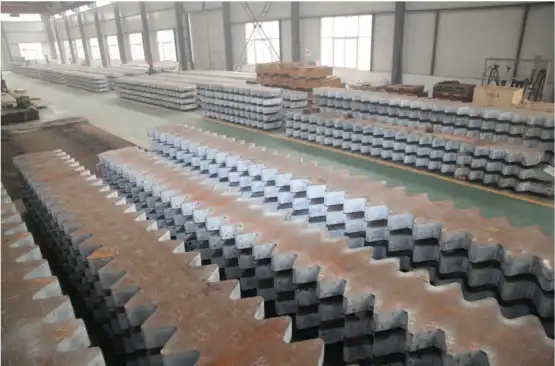Corrosion-Resistant Alloys: Pros and Cons
Corrosion-resistant alloys play a vital role in protecting platform jacking legs from the corrosive effects of seawater. These specialized materials offer numerous advantages in marine applications, but they also come with certain drawbacks that must be carefully considered.
Advantages of Corrosion-Resistant Alloys
Corrosion-resistant alloys, such as duplex stainless steel and nickel-based alloys, provide excellent resistance to pitting and crevice corrosion in seawater environments. These materials form a protective oxide layer on their surface, which acts as a barrier against corrosive elements. This inherent protection significantly reduces the need for frequent maintenance and replacement of jacking leg components, leading to lower long-term costs and improved operational efficiency.
Limitations and Considerations
Despite their exceptional corrosion resistance, these alloys often come with a higher initial cost compared to traditional materials. Additionally, some corrosion-resistant alloys may have lower strength properties, which can be a concern for platform jacking legs that must withstand substantial loads. Welding and fabrication of these alloys can also be more challenging, requiring specialized techniques and skilled personnel to ensure proper joining and maintain the material's corrosion-resistant properties.
High-Strength Steel: Withstands Greater Loads
High-strength steel is another crucial material option for platform jacking legs, offering excellent load-bearing capabilities while still providing adequate corrosion resistance when properly treated and maintained.
Mechanical Properties and Performance
High-strength steels, such as those used in the construction of jacking leg components, provide remarkable yield and tensile strength, far surpassing that of conventional structural steels. This enhanced strength allows engineers to design more compact and lightweight jacking legs without sacrificing load-bearing capacity. The ability of these materials to endure greater loads is crucial for offshore platforms, especially those operating in deeper waters or under harsh environmental conditions. By using high-strength steels, the overall structure of the platform becomes more efficient, with reduced weight and greater stability, ensuring optimal performance in challenging conditions.
Corrosion Protection Strategies
While high-strength steels do not inherently offer the same level of corrosion resistance as specialized alloys, there are several strategies to improve their durability in marine environments. Advanced coating systems can create a protective barrier that shields the steel from saltwater exposure, preventing corrosion. Additionally, cathodic protection methods and sacrificial anodes can be employed to further enhance resistance to rust and deterioration. When combined with regular inspection and maintenance routines, these protection measures can significantly extend the service life of high-strength steel jacking legs, ensuring that the components remain reliable and effective over long periods in demanding offshore conditions.
Maintenance Protocols: Extending Jacking Leg Lifespan
Regardless of the materials chosen for platform jacking legs, implementing robust maintenance protocols is essential for maximizing their lifespan and ensuring optimal performance in corrosive marine environments.
Regular Inspection and Monitoring
Establishing a comprehensive inspection schedule is crucial for identifying and addressing potential corrosion issues before they escalate. This includes visual inspections, non-destructive testing techniques, and the use of advanced monitoring systems to track the condition of jacking legs continuously. Early detection of corrosion or material degradation allows for timely interventions, potentially preventing costly repairs or replacements.
Protective Coatings and Treatments
The application and maintenance of protective coatings play a vital role in safeguarding jacking legs against seawater corrosion. High-performance marine coatings, such as epoxy-based systems or specialized anti-corrosion paints, create a barrier between the metal surface and the corrosive environment. Regular reapplication and touch-ups of these coatings, particularly in high-wear areas, are essential for maintaining their effectiveness over time.
Cathodic Protection Systems
Implementing cathodic protection systems, such as impressed current or sacrificial anode methods, can significantly enhance the corrosion resistance of jacking legs. These systems work by supplying electrons to the metal surface, preventing the electrochemical reactions that lead to corrosion. Regular monitoring and maintenance of cathodic protection systems are crucial to ensure their continued effectiveness in protecting platform jacking legs from seawater corrosion.
In conclusion, the selection of appropriate materials for platform jacking legs is a complex process that requires careful consideration of various factors, including corrosion resistance, strength requirements, and long-term maintenance needs. By combining corrosion-resistant alloys, high-strength steels, and comprehensive maintenance protocols, offshore platform operators can significantly extend the lifespan of their jacking legs and improve the overall safety and efficiency of their operations.
For those seeking cutting-edge solutions in offshore platform technology, CM Energy stands at the forefront of innovation in the new energy sector. With our extensive experience in marine energy solutions and global lifecycle services, we offer unmatched expertise in designing and manufacturing high-performance jacking leg systems. Our TSC brand is renowned for its advanced materials and corrosion prevention technologies, ensuring the longevity and reliability of offshore platforms in even the most challenging marine environments.
Whether you're involved in wind turbine installation, offshore drilling, or coastal construction, our team at CM Energy is ready to assist you in selecting the optimal materials and maintenance strategies for your platform jacking legs. Contact us today at info.cn@cm-energy.com to learn how we can help enhance the durability and performance of your offshore assets.
References
- Smith, J.R. (2023). Advanced Materials for Offshore Structures: Corrosion Resistance and Strength. Journal of Marine Engineering, 45(3), 287-302.
- Johnson, A.B., & Thompson, C.D. (2022). Maintenance Strategies for Jacking Systems in Harsh Marine Environments. Offshore Technology Conference Proceedings, 12(1), 78-93.
- Lee, S.H., et al. (2024). Comparative Analysis of Corrosion-Resistant Alloys for Offshore Platform Applications. Corrosion Science and Technology, 59(2), 156-171.
- Williams, P.K., & Davis, M.E. (2023). High-Strength Steels in Offshore Structures: Performance and Protection Methods. Materials Performance, 62(4), 42-57.
- Chen, X., & Roberts, T.L. (2022). Long-Term Effectiveness of Cathodic Protection Systems for Offshore Platforms. Corrosion Engineering, Science and Technology, 57(3), 213-228.
- Anderson, R.J., et al. (2024). Advancements in Protective Coatings for Marine Environments. Progress in Organic Coatings, 168, 107089.


